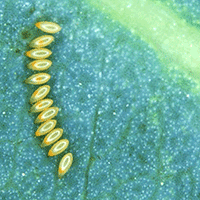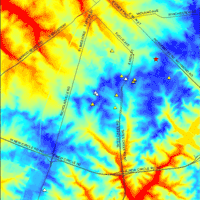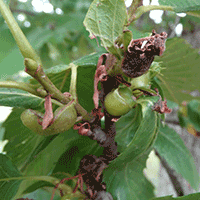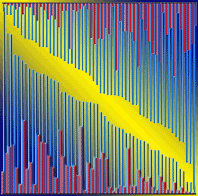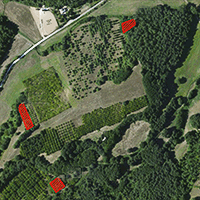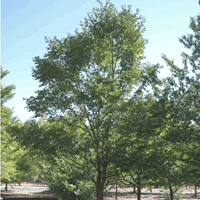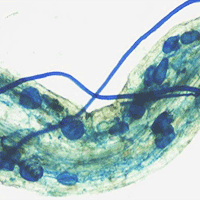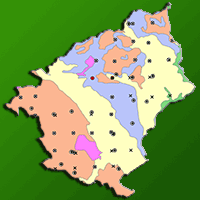The rapid growth and environmental adaptability of Eucalyptus species has favored their global cultivation for pulpwood production. On the island of Sardinia, Italy, eucalypt plantations were established in the 20th century primarily in areas reclaimed from marshland, but the trees are now grown all over the island as ornamentals or windbreaks, and for timber, pulp and honey production. In recent years, an unusual decline and mortality of unknown etiology has been observed in Eucalyptus camaldulensis (river red gum) plantations throughout the island. Given the ecological and economic importance of eucalypt ecosystems in Sardinia, a survey was carried out in 2013 to determine which insect pests and fungal pathogens are directly involved in these phenomena. Field surveys throughout the island revealed severe infestations with the red gum lerp psyllid (Glycaspis brimblecombei) at all 12 surveyed sites, with the greatest numbers of pre-imaginal stages and adults occurring between May and July. The adult population reached its peak in July, followed 2 months later by the peak population of its specific parasitoid, Psyllaephagus bliteus. Symptoms of leaf chlorosis, crown thinning, shoot and branch dieback, sunken cankers, epicormic shoots and exudations of kino gum were also observed at the 12 field sites. Symptomatic woody samples yielded fungal isolates representing three distinct families: Botryosphaeriaceae, Diaporthaceae and Valsaceae. Morphological and DNA sequence data revealed seven distinct fungal species, namely Diaporthe foeniculina, Neofusicoccum australe, N. luteum, N. mediterraneum, N. parvum, N. vitifusiforme and Valsa fabianae. Two putative new species of Cytospora were also identified. Neofusicoccum australe was the only species recovered from all 12 sites, with isolation frequencies of 51-95%. Pathogenicity trials revealed that all Neofusicoccum species except N. vitifusiforme are directly involved in the etiology of the observed decline in the E. camaldulensis population on Sardinia.
Keywords
, , ,
Citation
Deidda A, Buffa F, Linaldeddu BT, Pinna C, Scanu B, Deiana V, Satta A, Franceschini A, Floris I (2016). Emerging pests and diseases threaten Eucalyptus camaldulensis plantations in Sardinia, Italy. iForest 9: 883-891. - doi: 10.3832/ifor1805-009
Academic Editor
Alberto Santini
Paper history
Received: Aug 11, 2015
Accepted: Mar 05, 2016
First online: Jun 29, 2016
Publication Date: Dec 14, 2016
Publication Time: 3.87 months
© SISEF - The Italian Society of Silviculture and Forest Ecology 2016
Open Access
This article is distributed under the terms of the Creative Commons Attribution-Non Commercial 4.0 International (https://creativecommons.org/licenses/by-nc/4.0/), which permits unrestricted use, distribution, and reproduction in any medium, provided you give appropriate credit to the original author(s) and the source, provide a link to the Creative Commons license, and indicate if changes were made.

Breakdown by View Type
(Waiting for server response...)
Article Usage
Total Article Views: 61695
(from publication date up to now)
Breakdown by View Type
HTML Page Views: 49759
Abstract Page Views: 5778
PDF Downloads: 4645
Citation/Reference Downloads: 71
XML Downloads: 1442
Web Metrics
Days since publication: 3457
Overall contacts: 61695
Avg. contacts per week: 124.92
Article Citations
Article citations are based on data periodically collected from the Clarivate Web of Science web site
(last update: Mar 2025)
Total number of cites (since 2016): 18
Average cites per year: 1.80
Publication Metrics
by Dimensions ©
Articles citing this article
List of the papers citing this article based on CrossRef Cited-by.
(1)
Adams GC, Wingfield MJ, Common R, Roux J (2005)Phylogenetic relationships and morphology of
Cytospora species and related teleomorphs (
Ascomycota, Diaporthales, Valsaceae) from
Eucalyptus. Studies in Mycology 52: 1-144.
Gscholar
(2)
Adesemoye AO, Mayorquin JS, Wang DH, Twizeyimana M, Lynch SC, Eskalen A (2013)Identification of species of
Botryosphaeriaceae causing Bot gummosis in
Citrus in California. Plant Disease 98: 55-61.
CrossRef |
Gscholar
(3)
Alves A, Crous PW, Correia A, Phillips AJL (2008)Morphological and molecular data reveal cryptic species in
Lasiodiplodia theobromae. Fungal Diversity 28: 1-13.
Online |
Gscholar
(4)
Alves A, Linaldeddu BT, Deidda A, Scanu B, Phillips AJL (2014)The complex of
Diplodia species associated with
Fraxinus and some other woody hosts in Italy and Portugal. Fungal Diversity 67: 143-156.
CrossRef |
Gscholar
(5)
Andolfi A, Maddau L, Cimmino A, Linaldeddu BT, Franceschini A, Serra S, Basso S, Melck D, Evidente A (2012)Cyclobotryoxide, a phytotoxic metabolite produced by the plurivorous pathogen
Neofusicoccum australe. Journal of Natural Products 75 (10): 1785-1791.
CrossRef |
Gscholar
(6)
Barber PA, Burgess TI, Keane PJ, Hardy GESJ, Slippers B, Wingfield MJ (2005)Botryosphaeria species from
Eucalyptus in Australia are pleoanamorphic, producing
Dichomera synanamorphs in culture. Mycological Research 109: 1347-1363.
CrossRef |
Gscholar
(7)
Barradas C, Correia A, Alves A (2013)First report of
Neofusicoccum australe and
N. luteum associated with canker and dieback of
Quercus robur in Portugal. Plant Disease 97: 560.
Gscholar
(8)
Bella S, Rapisarda C (2013)First record from Greece of the invasive red gum lerp psyllid
Glycaspis brimblecombei Moore (Hemiptera: Psyllidae) and its associated parasitoid
Psyllaephagus bliteus Riek (Hymenoptera: Encyrtidae). Redia 96: 33-35.
Online |
Gscholar
(9)
Ben Attia S, Rapisarda C (2014)First record of the red gum lerp psyllid,
Glycaspis brimblecombei Moore (Hemiptera Psyllidae), in Tunisia. Phytoparasitica 42: 535-539.
CrossRef |
Gscholar
(10)
Boggia L (1987)Conclusioni sull’eucalitticoltura nazionale [Conclusion on the national eucalypt plantations]. Cellulosa e Carta 5: 11-17. [in Italian]
Gscholar
(11)
Branco M, Bragança H, Sousa E, Phillips AJL (2014)Pests and diseases in Portuguese forestry: current and new threats. In: “Forest context and policies in Portugal. Present and Future Challenges” (Reboredo F ed). World Forests 19: 117-154.
CrossRef |
Gscholar
(12)
Brennan EB, Gill R (1999)First record of
Glycaspis brimblecombei Moore (Homoptera: Psyllidae) in North America: Initial observations and predator associations of a potential serious new pest of Eucalyptus in California. Pan-Pacific Entomologist 75: 55-57.
Online |
Gscholar
(13)
Brennan EB, Hrusa GF, Weinbaum SA, Levison Jr W (2001)Resistance of
Eucalyptus species to
Glycaspis brimblecombei (Homoptera: Psyllidae) in the San Francisco Bay area. Pan-Pacific Entomologist 77: 249-253.
Online |
Gscholar
(14)
Brooker MIH (2000)A new classification of the genus
Eucalyptus L’Her. (Myrtaceae). Australian Systematic Botany 13 (1): 79-148.
CrossRef |
Gscholar
(15)
Buffa F (2015)Problematiche entomologiche dell’eucalipto in Sardegna e monitoraggio del fitofago di nuova introduzione Psylla lerp (
Glycaspis brimblecombei) [Entomological problems of eucalypt in Sardinia and monitoring of the newly introduced phytophagous Psilla lerp (
Glycaspis brimblecombei)]. PhD thesis, Department of Agriculture, University of Sassari, Sassari, Italy, pp. 78. [in Italian]
Gscholar
(16)
Burgess TI, Barber PA, Hardy GES (2005)Botryosphaeria spp. associated with eucalypts in Western Australia, including the description of
Fusicoccum macroclavatum sp. nov. Australasian Plant Pathology 34: 557-567.
CrossRef |
Gscholar
(17)
Burgess TI, Sakalidis ML, Hardy GES (2006a)Gene flow of the canker pathogen
Botryosphaeria australis between
Eucalyptus globulus plantations and native eucalypt forests in Western Australia. Austral Ecology 31: 559-566.
CrossRef |
Gscholar
(18)
Burgess TI, Barber PA, Mohali S, Pegg G, De Beer W, Wingfield MJ (2006b)Three new
Lasiodiplodia spp. from the tropics, recognized based on DNA sequence comparisons and morphology. Mycologia 98 (3): 423-435.
CrossRef |
Gscholar
(19)
Caleca V, Lo Verde G, Maltese M (2011)First record in Italy of
Psyllaephagus bliteus Riek (Hymenoptera Encyrtidae) parasitoid of
Glycaspis brimblecombei Moore (Hemiptera Psyllidae). Naturalista siciliano 2011: 435-444.
Online |
Gscholar
(20)
Cheon W, Kim YS, Lee SG, Jeon YH, Chun IJ (2013)First report of branch dieback of walnut caused by
Neofusicoccum parvum in Korea. Plant Disease 97 (8): 1114.
Gscholar
(21)
Cloete M, Fourie PH, Damm U, Crous PW, Mostert L (2011)Fungi associated with die-back symptoms of apple and pear trees with a special reference to grapevine trunk disease pathogens. Phytopathologia Mediterranea 50 (supplement): 176-190.
Online |
Gscholar
(22)
Coutinho TA, Wingfield MJ, Alfenas AC, Crous PW (1998)Eucalyptus rust: a disease with the potential for serious international implications. Plant Disease 82: 819-825.
CrossRef |
Gscholar
(23)
Crous PW, Wingfield MJ (1997)New species of
Mycosphaerella occurring on
Eucalyptus leaves in Indonesia and Africa. Canadian Journal of Botany 75: 781-790.
CrossRef |
Gscholar
(24)
Crous PW, Groenewald JZ, Wingfield MJ, Phillips AJL (2007a)Neofusicoccum mediterraneum. Fungal Planet 19: 2.
Gscholar
(25)
Crous PW, Braun U, Groenewald JZ (2007b)Mycosphaerella is polyphyletic. Studies in Mycology 58: 1-32.
CrossRef |
Gscholar
(26)
Daane KM, Sime KR, Dahlsten DL, Andrews Jr JW, Zuparko RL (2005)The biology of
Psyllaephagus bliteus Riek (Hymenoptera: Encyrtidae), a parasitoid of the red gum lerp psyllid (Hemiptera: Psylloidea). Biological Control 32: 228-235.
CrossRef |
Gscholar
(27)
Damm U, Crous PW, Fourie PH (2007)Botryosphaeriaceae as potential pathogens of
Prunus in South Africa, with descriptions of
Diplodia africana and
Lasiodiplodia plurivora sp. nov. Mycologia 99: 664-680.
CrossRef |
Gscholar
(28)
EPPO (2006)First report of two new eucalyptus pests in the south of France:
Ophelimus maskelli and
Leptocybe invasa. European and Mediterranean Plant Protection Organization, EPPO Reporting Service 9: 9.
Gscholar
(29)
Flynn B (2010)Eucalyptus: having an impact on the global solid wood industry. Wood Resources International, Web site.
Online |
Gscholar
(30)
Gezahgne A, Roux J, Slippers B, Wingfield MJ (2004)Identification of the causal agent of
Botryosphaeria stem canker in Ethiopian
Eucalyptus plantations. South African Journal of Botany 70: 241-248.
CrossRef |
Gscholar
(31)
Gomes RR, Glienke C, Videira SIR, Lombard L, Groenewald JZ, Crous PW (2013)Diaporthe: a genus of endophytic, saprobic and plant pathogenic fungi. Persoonia 31: 1-41.
CrossRef |
Gscholar
(32)
Gryzenhout M, Myburg H, Van Der Merwe NA, Wingfield BD, Wingfield MJ (2004)Chrysoporthe, a new genus to accommodate
Cryphonectria cubensis. Studies in Mycology 50: 119-142.
Online |
Gscholar
(33)
Inderbitzin P, Bostock RM, Trouillas FP, Michailides TJ (2010)A six-locus phylogeny reveals high species diversity in
Botryosphaeriaceae from California almond. Mycologia 102: 1350-1368.
CrossRef |
Gscholar
(34)
Kong CS, Qiu XL, Yi KS, Yu XF (2010)First report of
Neofusicoccum vitifusiforme causing Blueberry blight of blueberry in China. Plant Disease 94: 13732-13732.
CrossRef |
Gscholar
(35)
Lamari L (2002)Assess: image analysis software for plant disease quantification. APS Press, St Paul, MN, USA.
Gscholar
(36)
Laudonia S, Garonna AP (2010)The red gum lerp psyllid,
Glycaspis brimblecombei, a new exotic pest of
Eucalyptus camaldulensis in Italy. Bulletin of Insectology 63: 233-236.
Online |
Gscholar
(37)
Lazzizera C, Frisullo S, Alves A, Phillips AJL (2008)Morphology, phylogeny and pathogenicity of
Botryosphaeria and
Neofusicoccum species associated with drupe rot of olives in southern Italy. Plant Pathology 57: 948-956.
CrossRef |
Gscholar
(38)
Linaldeddu BT, Scanu B, Maddau L, Franceschini A (2011)Diplodia africana causing dieback disease on
Juniperus phoenicea: a new host and first report in the northern hemisphere. Phytopathologia Mediterranea 50 (3): 473-477.
Gscholar
(39)
Linaldeddu BT, Franceschini A, Alves A, Phillips AJL (2013)Diplodia quercivora sp. nov.: a new species of
Diplodia found on declining
Quercus canariensis trees in Tunisia. Mycologia 105 (5): 1266-1274.
CrossRef |
Gscholar
(40)
Linaldeddu BT, Scanu B, Maddau L, Franceschini A (2014)Diplodia corticola and
Phytophthora cinnamomi: the main pathogens involved in holm oak decline on Caprera island (Italy). Forest Pathology 44: 191-200.
CrossRef |
Gscholar
(41)
Linaldeddu BT, Deidda A, Scanu B, Franceschini A, Serra S, Berraf-Tebbal A, Zouaoui Boutiti M, Ben Jama ML, Phillips AJL (2015a)Diversity of
Botryosphaeriaceae species associated with grapevine and other woody hosts in Italy, Algeria and Tunisia, with descriptions of
Lasiodiplodia exigua and
Lasiodiplodia mediterranea sp. nov. Fungal Diversity 71: 201-2014.
CrossRef |
Gscholar
(42)
Linaldeddu BT, Scanu B, Seddaiu S, Deidda A, Maddau L, Franceschini A (2015b)A new disease of
Erica arborea in Italy caused by
Neofusicoccum luteum. Phytopathologia Mediterranea 54 (1): 124-127.
Online |
Gscholar
(43)
Lundquist JE, Purnell RC (1987)Effects of
Mycosphaerella leaf spot on growth of Eucalyptus nitens. Plant Disease 71 (11): 1025-1029.
CrossRef |
Gscholar
(44)
Marques MW, Lima NB, De Morais MA, Barbosa MA, Souza BO, Michereff SJ, Phillips AJ, C’mara MP (2013)Species of
Lasiodiplodia associated with mango in Brazil. Fungal Diversity 61 (1): 181-193.
CrossRef |
Gscholar
(45)
McDonald V, Lynch S, Eskalen A (2009)First report of
Neofusicoccum australe,
N. luteum, and
N. parvum associated with avocado branch canker in California. Plant Disease 93: 967.
Online |
Gscholar
(46)
McKinnon GE, Vaillancourt RE, Steane DA, Potts BM (2008)An AFLP marker approach to lower-level systematics in
Eucalyptus (Myrtaceae). American Journal of Botany 95: 368-380.
CrossRef |
Gscholar
(47)
Mercurio R, Minotta G (2000)Arboricoltura da legno [Arboriculture for wood production]. Ed. Clueb, Bologna, Italy, pp. 203. [in Italian]
Gscholar
(48)
Mohali S, Burgess TI, Wingfield MJ (2005)Diversity and host association of the tropical tree endophyte
Lasiodiplodia theobromae revealed using simple sequence repeat markers. Forest Pathology 35: 385-396.
CrossRef |
Gscholar
(49)
Mohali SR, Slippers B, Wingfield MJ (2007)Identification of
Botryosphaeriaceae from
Eucalyptus, Acacia and
Pinus in Venezuela. Fungal Diversity 25: 103-125.
Online |
Gscholar
(50)
Mondello V, Lo Piccolo S, Conigliaro G, Alfonzo A, Torta L, Burruano S (2013)First report of
Neofusiccoccum vitifusiforme and presence of other
Botryosphaeriaceae species associated with
Botryosphaeria dieback of grapevine in Sicily (Italy). Phytopathologia Mediterranea 52: 388-396.
Online |
Gscholar
(51)
Old KM, Gibbs R, Craig I, Myers BJ, Yaun ZQ (1990)Effect of drought and defoliation on the susceptibility of
Eucalyptus to cankers caused by
Endothia gyrosa and
Botryosphaeria ribis. Australian Journal of Botany 38: 571-581.
CrossRef |
Gscholar
(52)
Ohmart CP, Edwards PB (1991)Insect herbivory on
Eucalyptus. Annual Reviews of Entomology 36: 637-657.
CrossRef |
Gscholar
(53)
Paine TD, Dahlsten DL, Millar JG, Hoddle MS, Hanks LM (2000)UC scientists apply IPM techniques to new eucalyptus pests. California Agriculture 54: 8-13.
CrossRef |
Gscholar
(54)
Paine TD, Millar JG (2002)Insect pests of eucalypts in California: implications of managing invasive species. Bulletin of Entomological Research 92: 147-151.
CrossRef |
Gscholar
(55)
Phillips AJL, Alves A, Abdollahzadeh J, Slippers B, Wingfield MJ, Groenewald JZ, Crous PW (2013)The
Botryosphaeriaceae: genera and species known from culture. Studies in Mycology 76: 51-167.
CrossRef |
Gscholar
(56)
Reguia K, Peris-Felipo FJ (2013)Glycaspis brimblecombei Moore, 1964 (Hemiptera Psyllidae) invasion and new records in the Mediterranean area. Biodiversity Journal 4 (4): 501-506.
Online |
Gscholar
(57)
Roux J, Coutinho TA, Mujuni Byabashaija D, Wingfield MJ (2001)Diseases of plantation Eucalyptus in Uganda. South African Journal of Science 97: 16-18.
Gscholar
(58)
Roux J, Wingfield MJ (2009)Ceratocystis species: emerging pathogens of non-native plantations
Eucalyptus and
Acacia species. Southern Forests 71 (2): 115-120.
CrossRef |
Gscholar
(59)
Sánchez Márquez S, Bills GF, Zabalgogeazcoa I (2011)Fungal species diversity in juvenile and adult leaves of
Eucalyptus globulus from plantations affected by
Mycosphaerella leaf disease. Annals of Applied Biology 158: 177-187.
CrossRef |
Gscholar
(60)
Sharma JK, Mohanan C, Maria Florence EJ (1984)A new stem canker disease of
Eucalyptus caused by
Botryodiplodia theobromae in India. Transactions of the British Mycological Society 83: 162-163.
CrossRef |
Gscholar
(61)
Sharma A, Raman A, Taylor G, Murray Fletcher M (2013)Nymphal development and lerp construction of
Glycaspis sp. (Hemiptera: Psylloidea) on
Eucalyptus sideroxylon (Myrtaceae) in central-west New South Wales, Australia. Arthropod Structure and Development 42: 55-564.
CrossRef |
Gscholar
(62)
Slippers B, Fourie G, Crous PW, Coutinho TA, Wingfield BD, Carnegie AJ, Wingfield MJ (2004)Speciation and distribution of
Botryosphaeria spp. on native and introduced
Eucalyptus trees in Australia and South Africa. Studies in Mycology 50: 343-358.
Online |
Gscholar
(63)
Slippers B, Burgess T, Pavlic D, Ahumada R, Maleme H, Mohali S, Rodas C, Wingfield MJ (2009)A diverse assemblage of
Botryosphaeriaceae infect
Eucalyptus in native and non-native environments. Southern Forests 71: 101-110.
CrossRef |
Gscholar
(64)
Smith H, Kemp GHJ, Wingfield MJ (1994)Canker and dieback of
Eucalyptus in South Africa caused by
Botryosphaeria dothidea. Plant Pathology 43: 1031-1034.
CrossRef |
Gscholar
(65)
Smith DR, Stanosz GR (2001)Molecular and morphological differentiation of
Botryosphaeria dothidea (anamorph
Fusicoccum aesculi) from some other fungi with
Fusicoccum anamorphs. Mycologia 93 (3): 505-515.
CrossRef |
Gscholar
(66)
Spodek M, Burckhardt D, Protasov A, Mendel Z (2015)First record of two invasive eucalypt psyllids (Hemiptera: Psylloidea) in Israel. Phytoparasitica 43 (3): 401-406.
CrossRef |
Gscholar
(67)
Tamesse JL, Soufo L, Wenceslas Y, Dzokou VJ (2010)First record of
Blastopsylla occidentalis Taylor, 1985 (Hemiptera: Psyllidae), a
Eucalyptus psyllid in Cameroon, Central Africa. Entomological Research 40 (4): 211-216.
CrossRef |
Gscholar
(68)
Trouillas FP, Urbez-Torres JR, Peduto F, Gubler WD (2010)First report of twig and branch dieback of English walnut (
Juglans regia) caused by
Neofusicoccum mediterraneum in California. Plant Disease 94: 1267. -
Online |
Gscholar
(69)
Urbez-Torres JR, Peduto F, Gubler WD (2010)First report of grapevine cankers caused by
Lasiodiplodia crassispora and
Neofusicoccum mediterraneum in California. Plant Disease 94: 785. -
Online |
Gscholar
(70)
Urbez-Torres JR (2011)The status of
Botryosphaeriaceae species infecting grapevines. Phytopathologia Mediterranea 50: S5-S45.
Online |
Gscholar
(71)
Van Niekerk JM, Crous PW, Groenewald JZ, Fourie PH, Halleen F (2004)DNA phylogeny, morphology and pathogenicity of
Botryosphaeria species on grapevines. Mycologia 96: 781-798.
CrossRef |
Gscholar
(72)
Webb RS (1983)Seed capsule abortion and twig dieback of
Eucalyptus camaldulensis in South Florida induced by
Botryosphaeria ribis. Plant Disease 67: 108-109.
CrossRef |
Gscholar
(73)
White TJ, Bruns T, Lee S, Taylor J (1990)Amplification and direct sequencing of fungal ribosomal RNA genes for phylogenies. In: “PCR protocols: A guide to methods and applications” (Innis MA, Gelfand DH, Sninsky JJ, White TJ eds). Academic Press, San Diego, CA, USA, pp. 315-322.
Gscholar
(74)
Wilcken CF, Soliman EP, Nogueira De Sá LA, Barbosa LR, Dias TKR, Ferreira-Filho PJ, Oliveira RJR (2010)Bronze bug
Thaumastocoris peregrinus Carpintero and Dellapé (Hemiptera: Thaumastocoridae) on
Eucalyptus in Brazil and its distribution. Journal of Plant Protection Research 50 (2): 201-205.
CrossRef |
Gscholar
(75)
Wingfield MJ, Slippers B, Hurley BP, Coutinho TA, Wingfield BD, Roux J (2008)Eucalypt pests and diseases: growing threats to plantation productivity. Southern Forests 70: 139-144.
CrossRef |
Gscholar
